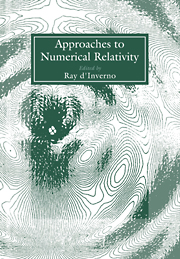Book contents
- Frontmatter
- Contents
- Contributors
- Introduction
- Preface
- PART A THEORETICAL APPROACHES
- PART B PRACTICAL APPROACHES
- Numerical asymptotics
- Instabilities in rapidly rotating polytropes
- Gravitational radiation from coalescing binary neutron stars
- “Critical” behaviour in massless scalar field collapse
- Godunov-type methods applied to general relativistic stellar collapse
- Astrophysical sources of gravitational waves and neutrinos
- Gravitational radiation from 3D gravitational stellar core collapse
- A vacuum fully relativistic 3D numerical code
- Solution of elliptic equations in numerical relativity using multiquadrics
- Self-gravitating thin discs around rotating black holes
- An ADI scheme for a black hole problem
- Time-symmetric ADI and causal reconnection
- The numerical study of topological defects
- Computations of bubble growth during the cosmological quark-hadron transition
- Initial data of axisymmetric gravitational waves with a cosmological constant
- PANEL DISCUSSION
Solution of elliptic equations in numerical relativity using multiquadrics
Published online by Cambridge University Press: 15 December 2009
- Frontmatter
- Contents
- Contributors
- Introduction
- Preface
- PART A THEORETICAL APPROACHES
- PART B PRACTICAL APPROACHES
- Numerical asymptotics
- Instabilities in rapidly rotating polytropes
- Gravitational radiation from coalescing binary neutron stars
- “Critical” behaviour in massless scalar field collapse
- Godunov-type methods applied to general relativistic stellar collapse
- Astrophysical sources of gravitational waves and neutrinos
- Gravitational radiation from 3D gravitational stellar core collapse
- A vacuum fully relativistic 3D numerical code
- Solution of elliptic equations in numerical relativity using multiquadrics
- Self-gravitating thin discs around rotating black holes
- An ADI scheme for a black hole problem
- Time-symmetric ADI and causal reconnection
- The numerical study of topological defects
- Computations of bubble growth during the cosmological quark-hadron transition
- Initial data of axisymmetric gravitational waves with a cosmological constant
- PANEL DISCUSSION
Summary
Abstract. We use the multiquadric approximation scheme for the solution of a three-dimensional elliptic partial differential equation occurring in 3 + 1 numerical relativity. This equation describes two-black-hole initial data, which will be a starting point for time-evolution computations of interacting black holes and gravitational wave production.
INTRODUCTION
Adopting the Arnowitt-Deser-Misner (ADM) 3 + 1 description of general relativity (1962) has, over the years, proved to be a fruitful approach for numerical relativity calculations. Using this description spacetime is constructed as a foliation of spacelike hyper surfaces. This split into space plus time leads to a constrained system of equations so that initial data must be specified on a spatial hypersurface and evolved into the future. The specification of initial data necessarily involves the solution of elliptic partial differential equations; these being the Hamiltonian and momentum constraints. When combined with York's conformal approach (1979) the system of elliptic equations is well-posed for solution by numerical techniques.
Until a few years ago the standard approach adopted by numerical relativists for the construction of initial data consisted of finite-differencing the constraint equations and applying iterative techniques, such as simultaneous-over-relaxation, to the resulting matrix of algebraic equations. More recently direct matrix solvers such as conjugate gradient and its variations have been employed (Evans 1986; Oohara and Nakamura 1989; Laguna et al 1991). A sophisticated multilevel iterative scheme developed by Brandt (1977) has also been used in numerical relativity calculations, mainly by Choptuik (1982, 1986), Lanza (1986, 1987) and Cook (1990, 1991).
- Type
- Chapter
- Information
- Approaches to Numerical Relativity , pp. 265 - 280Publisher: Cambridge University PressPrint publication year: 1992
- 4
- Cited by

